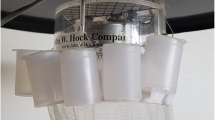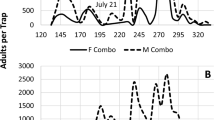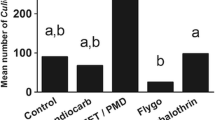Abstract
A large-scale field test using pheromone-acaricide-impregnated plastic tail-tag decoys demonstrated excellent efficacy of these devices for control of the bont tick,Amblyomma hebraeum, on cattle in Zimbabwe. The tail tags were impregnated with a mixture containingo-nitrophenol, methyl salicylate, 2,6-dichlorophenol and phenylacetaldehyde and one of three different acaricides (cyfluthrin, flumethrin or alphacypermethrin).o-Nitrophenol and methyl salicylate are components of theA. hebraeum attraction-aggregation-attachment pheromone, while 2,6-dichlorophenol and phenylacetaldehyde are proven attractants for this tick. Botho-nitrophenol and methyl salicylate were lost gradually from the tags over 12 and 14 week periods, respectively. In field trials, tick counts were compared between cattle that received tail tags either impregnated with pheromone mixture alone, cyfluthrin and pheromone mixture, flumethrin and pheromone mixture, alphacypermethrin and pheromone mixture or were left untreated. During the first 3 month trial period, control of adult bont ticks was 94.9% with cyfluthrin tail tags and 87.5% with flumethrin tail tags. In general, there was no significant difference in bont tick numbers on cattle without tags and those with tail tags containing pheromone only. When the trial was repeated for another 3 month period, control of bont ticks with tail tags containing cyfluthrin and flumethrin was 99.3 and 95.1%, respectively. However, control of bont ticks using alphacypermethrin was only 79.2%. Overall, retention of tail tags was excellent although some loss was encountered during the rainy season. In addition to controlling bont ticks, the tail tags provided moderate control of other tick species (Rhipicephalus evertsi evertsi, Rhipicephalus zambeziensis andHyalomma spp.) simultaneously infesting cattle in the trials.
Similar content being viewed by others
References
Beadles, M.L., Gingrich, A.R. and Millar, J.A. 1977. Slow-release devices for livestock insect control: cattle body surfaces contacted by five types of devices. J. Econ. Entomol. 70: 72–75.
Drummond, R.O., George, J.E. and Kunz, S.E. 1988. Control of Arthropod Pests of Livestock: A Review of Technology. CRC Press, Inc., Boca Raton, FL.
Gladney, W.J., Grabbe, R.R., Ernst, S.E. and Oehler, D.D. 1974. The Gulf Coast tick: evidence of a pheromone produced by males. J. Med. Entomol. 11: 303–306.
Hogsette, J.A. and Ruff, J.P. 1987. Control of stable flies and horn flies (Diptera: Muscidae) with permethrin tapes applied to tails of beef and dairy cattle. J. Econ. Entomol. 80: 417–420.
Lusby, W.R., Sonenshine, D.E., Yunker, C.E., Norval, R.A. and Burridge, M.J. 1991. Comparis of known and suspected pheromonal constituents in males of the African ticks,Amblyomma hebraeum Koch andAmblyomma variegatum (Fabricius). Exp. Appl. Acarol. 13: 143–152.
Miller, J.A. and George, J.E. 1994. Efficacy of a combination neckband and tail tag containing amitraz or cyhalothrin K against lone star ticks on pastured cattle. J. Agricult. Entomol. 11: 165–176.
Mount, G.A., Grothaus, R.H., Reed, J.T. and Baldwin, K.F. 1976.Amblyomma americanum: area control with granules or concentrated sprays of diazinon, propoxur and chlorpyrifos. J. Econ. Entomol. 69: 257–259.
Norval, R.A.I. and Rechav, Y. 1979. An assembly pheromone and its perception in the tickAmblyomma variegatum (Acarina: Ixodidae). J. Med. Entomol. 16: 507–511.
Norval, R.A.I., Butler, J.F. and Yunker, C.E. 1989a. Use of carbon dioxide and natural or synthetic aggregation-attachment pheromone of the bont tick,Amblyomma hebraeum, to attract and trap unfed adults in the field. Exp. Appl. Acarol. 7: 171–180.
Norval, R.A.I., Andrew, H.R. and Yunker, C.E. 1989b. Pheromone-mediation of host selection in both ticks (Amblyomma hebraeum Koch). Science 243: 364–365.
Norval, R.A.I., Peter, T., Yunker, C.E., Sonenshine, D.E. and Burridge, M.J. 1991a. Responses of the ticksAmblyomma hebraeum andA. variegatum to known or potential components of the aggregation-attachment pheromone. I. Long-range attraction. Exp. Appl. Acarol. 13: 11–18.
Norval, R.A.I., Peter, T., Yunker, C.E., Sonenshine, D.E. and Burridge, M.J. 1991b. Responses of the ticks,Amblyomma hebraeum andA. variegatum to known or potential components of the aggregation-attachment pheromone. II. Attachment stimulation. Exp. Appl. Acarol. 13: 19–26.
Norval, R.A.I., Peter, T., Sonenshine, D.E. and Burridge, M.J. 1992a. Responses of the ticksAmblyomma hebraeum andA. variegatum to known or potential components of the aggregation-attachment pheromone. III. Aggregation. Exp. App. Acarol. 16: 237–245.
Norval, R.A.I., Andrew, H.R., Yunker, C.E. and Burridge, M.J. 1992b. Biological process in the epidemiology of heartwater. In Tick vector biology. Medical and veterinary aspects, B. Fivaz, T. Petney and I. Horak (eds), pp. 71–86. Springer-Verlag, Berlin.
Norval, R.A.I., Sonenshine, D.E., Meltzer, M.I. and Burridge, M.J. 1994a. Attractant Decoy for Controlling Bont Ticks. United States Patent No. 5,296,227, US Patent Office, Washington, DC.
Norval, R.A.I., Perry, B.D., Meltzer, M.I., Kruska, R.L. and Booth, T.H. 1994b. Factors affecting the distributions of the tickAmblyomma hebraeum andA. variegatum in Zimbabwe: implications of reduced acaricide usage. Exp. Appl. Acarol. 18: 383–407.
Oberem, P.T. and Bezuidenhout, J.D. 1987. Heartwater in hosts other than domestic ruminants. Onderstepoort J. Vet. Res. 54: 271–275.
Price, T.L.Jr, Sonenshine, D.E., Norval, R.A.I., Yunker, C.E. and Burridge, M.J. 1994. Pheromonal composition of two species of AfricanAmblyomma ticks: similarities, differences and possible species specific components. Exp. Appl. Acarol. 18: 37–50.
Rechav, Y. and Whitehead, G.B. 1978. Field trials with pheromone-acaricide mixtures for control ofAmblyomma hebraeum. J. Econ. Entomol. 71: 149–151.
Rechav, Y., Whitehead, G.B. and Knight, M.M. 1976. Aggregation responses of nymphs to pheromone(s) produced by males of the tick,Amblyomma hebraeum (Koch). Nature 259: 563–564.
Schoni, R., Hess, R., Blum, W. and Ramstein, K. 1984. The aggregation-attachment pheromone of the bont tickAmblyomma variegatum Fabricius (Acari: Ixodidae). Isolation, identification, and action of its active components. J. Insect Physiol. 30: 613–618.
Schroder, J. and Van Schalkwyk, P.C. 1988. Die doeltreffendheid van alfametriendeurweekte oorplaatjies teen beesbosluise. J. S. Afr. Vet. Assoc. 60: 79–82.
Taylor, S.M., Elliott, C.T. and Blanchflower, W.J. 1987. A comparison of cypermethrin distribution on cattle hair after application of impregnated ear and tail tags. Pestic. Sci. 21: 39–43.
Van der Merwe, L. 1987. The infection and treatment method of vaccination against heartwater. Onderstepoort J. Vet. Res. 54: 489–492.
Walker, J.B. and Olwage, A. 1987. The tick vectors ofCowdria ruminantium (Ixodoidea, Ixodidae, genusAmblyomma) and their distribution. Onderstepoort J. Vet. Res. 54: 353–379.
Yunker, C.E., Peter, T., Norval, R.A.I., Sonenshine, D.E., Burridge, M.J. and Butler, J.F. 1992. Olfactory responses ofAmblyomma hebraeum andA. variegatum adults to attractant chemicals in laboratory tests. Exp. Appl. Acarol. 13: 295–301.
Author information
Authors and Affiliations
Additional information
Deceased.
Rights and permissions
About this article
Cite this article
Norval, R.A.I., Sonenshine, D.E., Allan, S.A. et al. Efficacy of pheromone-acaricide-impregnated tail-tag decoys for controlling the bont tick,Amblyomma hebraeum (Acari: Ixodidae), on cattle in Zimbabwe. Exp Appl Acarol 20, 31–46 (1996). https://doi.org/10.1007/BF00051475
Issue Date:
DOI: https://doi.org/10.1007/BF00051475




